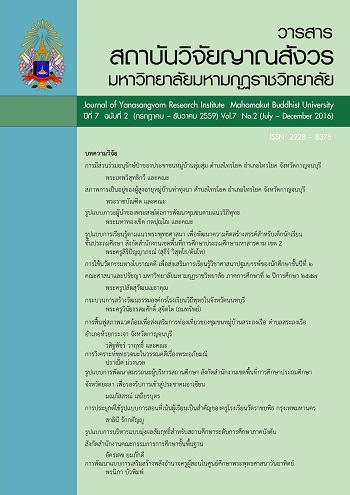นวัตกรรมกับกระบวนทัศน์การศึกษาศตวรรษที่ 21
Main Article Content
Abstract
จากสังคมยุคเกษตรกรรมในศตวรรษที่ 18 เปลี่ยนผ่านเข้าสู่สังคมยุคอุตสาหกรรมในศตวรรษที่ 19 และ 20 และกำลังเปลี่ยนผ่านเข้าสู่สังคมยุคความรู้แห่งศตวรรษที่ 21 ด้วยพลังขับของเทคโนโลยีดิจิตอลที่มีการเปลี่ยนแปลงอย่างรวดเร็ว เป็นความรวดเร็วที่นักวิชาการเห็นตรงกันว่าเพิ่งจะเริ่มต้นเท่านั้น ในระยะถัดไปจะยิ่งทวีความรวดเร็วขึ้นเป็นทวีคูณนอกจากนั้น นักวิชาการบางท่านได้ทำนายว่า ในอนาคตอันใกล้นี้จะเปลี่ยนผ่านเป็นสังคมยุคนวัตกรรมกันแล้ว ซึ่งการเปลี่ยนแปลงดังกล่าวมีความสัมพันธ์กับการเปลี่ยนแปลงทางการศึกษาด้วย แนวคิดใหม่ๆ ทฤษฎีใหม่ๆ ถูกพัฒนาขึ้น เกิดกระบวนทัศน์ใหม่เชิงเปรียบเทียบกับกระบวนทัศน์เก่ามากมาย ซึ่งเป็นที่ตระหนักกันดีว่า จุดมุ่งหมายพื้นฐานทางการศึกษาคือ การเรียนรู้ (learning) เพื่อความเป็นมนุษย์ที่สามารถดำรงอยู่ในโลกตามยุคสมัยได้อย่างมีคุณภาพ เมื่อสังคมเปลี่ยน กระบวนทัศน์ทางการศึกษาเปลี่ยน นักวิชาการก็เห็นตรงกันว่า หากยังหลงติดอยู่กับสิ่งเก่าที่เคยใช้ได้ผลในยุคเก่า ย่อมจะส่งผลให้การเรียนรู้ของผู้เรียนไม่สอดคล้องกับโลกที่เป็นจริง ทั้งในปัจจุบันและในอนาคตที่จะยิ่งเข้มข้นขึ้นนั้น
Article Details
References
วิกิพีเดีย สารานุกรมเสรี (2559). นวัตกรรม. ค้นเมื่อ 22 มกราคม 2559 จาก https://th.wikipedia.org/wiki/%E0%B8% 99%E0% B8%A7%E0%B8%B1%E0%B8%95%E0%B8%81%E0%B8%A3%E0%B8%A3%E0%B8%A1
21st Century Schools.com (2008). 21st century schools. Retrieved 21 January 2013, from http://www.21stcenturyschools.com/what_is_21st_century _education.htm
Apple Classrooms of Tomorrow – Today (ACOT2) (n.d.). Six design principles for the 21st century high school. Retrieved January 4, 2013, from http://education.apple. com/acot2/principles/
Churches, A. (2008). 21st century pedagogy. Retrieved January 10, 2013, from http://edorigami. edublogs.org/2008/08/16/21st-century-pedagogy/
Conley, D. (2010). College and career ready: Helping all students succeed beyond high school. San Francisco: Jossey-Bass.
Costa, A. and Kallick, B. (2012). 21st century Learning: Preparing students for complex futures. Retrieved February 23, 2013, from http://www.teach thought.com/learning /21st-century-learning-preparing-students-for-complex-futures/
Credaro, A. (2006). Innovation and change in education. Retrieved December 5, 2015, from http://www. warriorlibrarian.com/LIBRARY/innovate.html
Educational Origami (n.d.) . 21st century learning space. Retrieved January 27, 2013, from http://edoriga mi. wikispaces.com/21st+Century+Learning+Spaces
Gorman, M. (2012). 21st Century educational technology and learning. Retrieved February 26, 2013, from http://21centuryedtech.wordpress. com/2012/10/06/part-1-professional-education-learning-communities-definition-process-common-core/
Heick, T. (2012). 10 characteristics of a highly effective learning environment. Retrieved January 22, 2013, from http://www.teachthought.com/learning/10-characteristics-of-a-highly-effective-learning-environment/
Juke, I. and Dosaj, A. (2006). Understanding digital children (DKs): Teaching & learning in the new digital landscape. Retrieved February 25, 2013, from http://edorigami.wikispaces.com/file/view/Jukes+-+Understanding+ Digital+Kids.pdf
Prenksy, M. (2001). Digital natives, digital immigrants in the horizon (MCB University Press, Vol. 9 No. 5, October 2001). Retrieved February 18, 2013, from http://www.marcp rensky.com/writing/ prensky%20%20digital%20natives,% 20digital%20immigrants%20-%20part1.pdf
Ryshke, R. (2012). What schools can do to encourage innovation? Retrieved December 5, 2014, from http://rryshke.wordpress.com/2012/02/26/what-schools-can-do-to-encourage-innovation/
Sahu, A. (2013). Why education needs innovation? . Retrieved December 5, 2014, from http://anilsahu77 .blogspot.com/2013/08/why-education-needs-innovation.html
The Choices Program (n.d.). Choices curricula promote 21st century skills. Retrieved January 21, 2013 from http://www.choices.edu/about/21st-century-skills.php
The Victorian Council of School Organizations Inc. (VICCSO) (2012). A 21st century curriculum - discussion paper. Retrieved January 22, 2013, from http://www.viccso.org.au/big-ideas/a-21st-century-curriculum
Victor, J. (n.d.) Ten attitudes for effective 21st century leaders. Retrieved January 6, 2013 from http://www.ehow.com/info_8489161_10-effective-21st-century-leaders.html
Wagner, T. (2010). The global achievement gap: Why even our best schools don't teach the new survival skills our children need--and what we can do about it. Retrieved January 20, 2016, from http://www.amazon.com/The-Global-Achievement-Gap-Need/dp/0465002307
Wikipedia, the free encyclopedia (2016). Innovation. Retrieved January 22, 2016, from https://en.wikip edia.org/wiki/Innovation
Word Press (2011). Characteristics of a 21st century learner. Retrieved February 12, 2013, from http://blog.core-ed.org/tessa/2011/11/08/characteristics-of-a-21st-century-learner/


